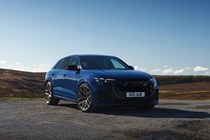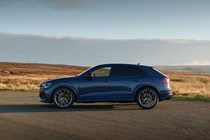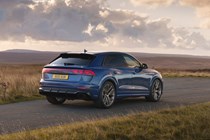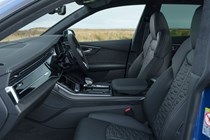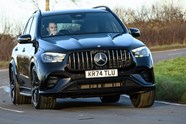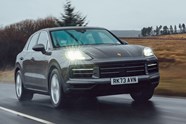Audi RS Q8 review (2024-)
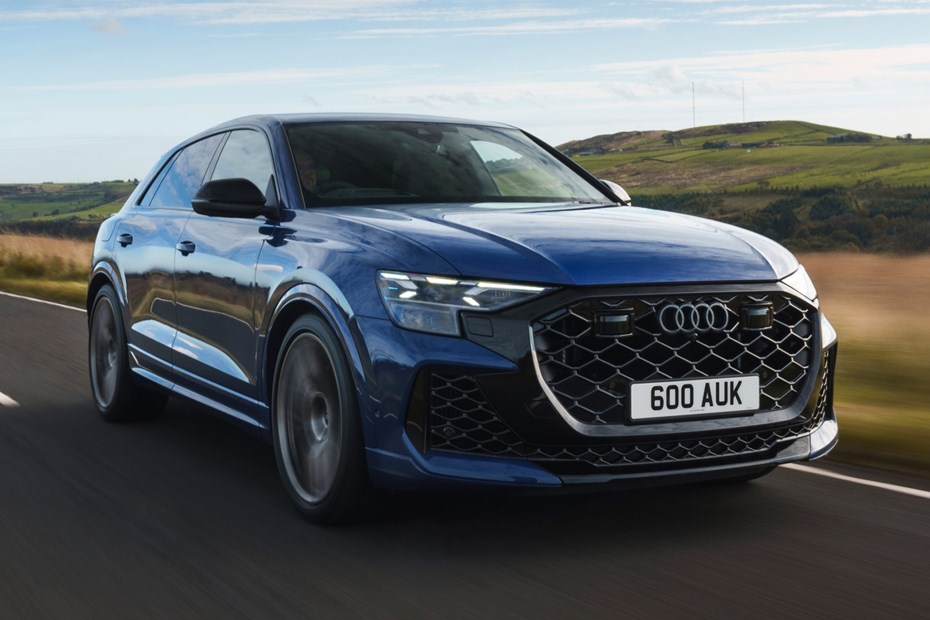
At a glance
| Price new | £125,025 - £159,375 |
|---|---|
| Used prices | £81,876 - £108,304 |
| Road tax cost | £620 |
| Insurance group | 50 |
Get an insurance quote with

|
|
| Fuel economy | 20.8 - 21.4 mpg |
| Miles per pound | 3.1 |
| Number of doors | 5 |
| View full specs for a specific version | |
Available fuel types
Petrol
Pros & cons
- Incredible performance from its V8 engine
- Handles very well for its size
- Practical and surprisingly comfortable
- Sky-high running costs
- Interior is really showing its age
- Rivals are slightly more engaging to drive
Audi Q8 RS Q8 rivals
Overview
The market for high-end performance SUVs is lucrative, not least for Audi, which has shifted a surprising number of RSQ8s since its introduction in 2020. Based on the standard Q8 SUV, its coupe-styled SUV flagship, it packs a mighty 4.0-litre V8 engine developing a significant 600hp.
It’s capable of out-pacing many performance cars, yet still can be used as an everyday family car, with its huge boot and spacious interior that can comfortably accommodate five adults. It’s this all-around usability that has helped SUVs of this calibre to become so popular. Key alternatives for the RSQ8 include the Porsche Cayenne and Bentley Bentayga, while if you have more cash to spend, the Ferrari Purosangue, Lamborghini Urus and Aston Martin DBX707 each represent the pinnacle of this class, but are significantly more expensive.
The RSQ8 has now been updated, following on from a mid-life refresh for the Q8 and sportier SQ8. The most major change is the introduction of a new range-topping ‘Performance’ variant – a nameplate reserved for Audi’s flagship RS models, including the RS6 and RS7 Performance.
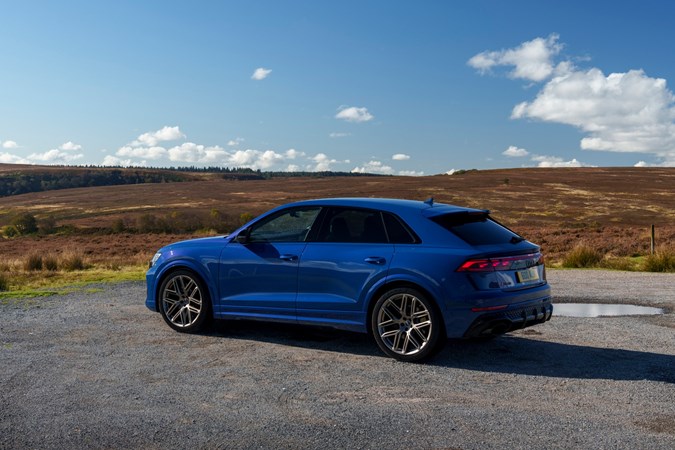
A number of revisions under the bonnet see the RSQ8 Performance’s power output increase to 640hp, while it also comes with a lighter sports exhaust and reduced sound insulation to amplify the engine and exhaust note. The Performance model is also equipped with many extras that are usually optional – including carbon ceramic brakes and an anti-roll bar that works to keep the car flatter through corners.
Styling changes are fairly small, however, with new LED headlights and a redesigned grille being the two most obvious changes. There are new 23-inch alloy wheels available on the options list, while the Performance model gets new matt carbon detailing that appears across the exterior.
We’ve driven the new Audi RSQ8 Performance extensively on track and road in Europe, and also driven the refreshed RSQ8 in the UK to give you an informed decision on whether you should buy one. Read more about here how we test cars at Parkers.
What’s it like inside?
The Q8’s interior was quite show-stopping when it was revealed back in 2018, but time hasn’t been massively kind to it, and these days it’s starting to show its age. The RS model features a twin-touchscreen interior layout, with the top display handling traditional media functions and the lower display controlling the climate control and heated seats. It’s good to look at, but neither screen are especially intuitive to use and have a slight lag – the displays in a BMW X5 M Competition work better.
There are various sporty touches throughout the RSQ8’s interior to set it apart from the standard model, too, most notably the generous use of Alcantara, which builds with the trim level. The highest-spec models feature the material, associated with sportiness, on the steering wheel, seats, door cards and even the roof lining. All the Alcantara in the world can’t take away from the fact that the interior just doesn’t quite posh enough for a £150,000 car.
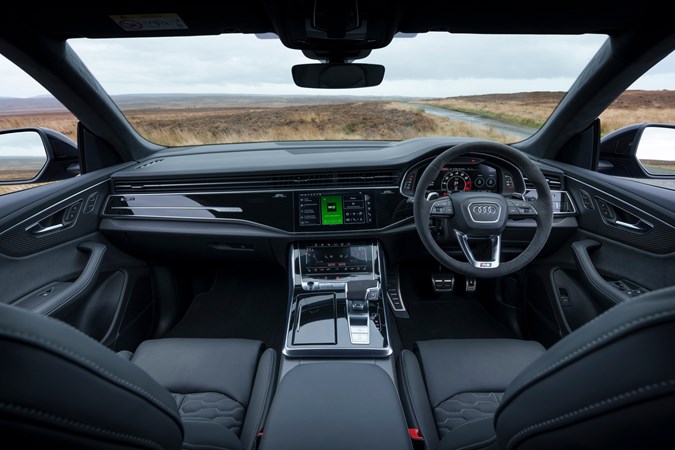
The one area we can’t criticise is the interior space on offer, which is extremely generous. Unlike the three-row Audi Q7, the RSQ8 is a five-seater, but with its wide interior dimensions, can comfortably accommodate five adults. The rear seats also slide forward to aid practicality, while the 605-litre boot is huge and ideal for family duties.
Engines
The RSQ8 uses a 4.0-litre twin-turbo V8 engine which, unlike rivals from Porsche and Lamborghini, doesn’t use plug-in hybrid technology. Instead, it’s a big, brawny unit that only features the smallest bit of mild hybrid assistance. In its standard guise, the RSQ8 develops 600hp and 800Nm of torque (pulling power), but on the new Performance model, this increases to 640hp and 850Nm of torque. An eight-speed tiptronic automatic gearbox is also used, along with quattro all-wheel-drive.
Sprinting to 62mph takes just 3.8 seconds with the standard car, and boasts a top speed limited to 155mph, while the Performance drops this to 3.6 seconds and raises the top speed limiter to 174mph.
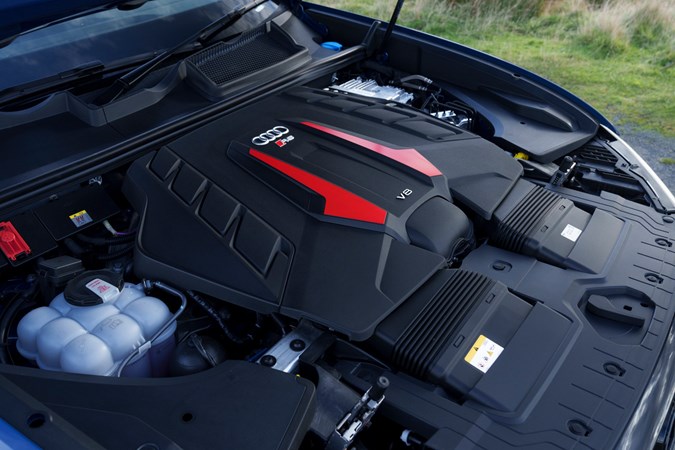
Though the running costs of the RSQ8 are significant, they’re not quite as terrible as we envisaged – on our UK drive we averaged 22mpg, matching the official figures.
What’s it like to drive?
So far we’ve driven the regular facelifted RSQ8 on UK roads and the new Performance variant abroad on both road and track. The key mechanical difference between them is that the Performance includes carbon ceramic brakes as standard, as well as a lighter sports exhaust system and more power.
Even without that extra 40hp, the standard RSQ8 is not exactly lacking, with fierce power delivery and great noise from its V8 engine. The Performance model provides more of a surge, and with its reduced sound deadening and more raucous sports exhaust, it is the one to have if you’re set on spending this much money on an SUV.
The stopping power from those ceramic brake systems is superb with their ability to bring 2.4 tonnes of SUV to a swift halt in a remarkable fashion. The car can squirm if you stamp on the brakes, but that’s more of sheer physics coming into play. The RSQ8 generally handles its mass well, with much of that down to its impressive electronic anti-roll bar that helps to keep the car almost completely flat through the corners. It’s quite remarkable, really. The steering is a bit too light for our liking but is easy to place through a fast, flowing corner.
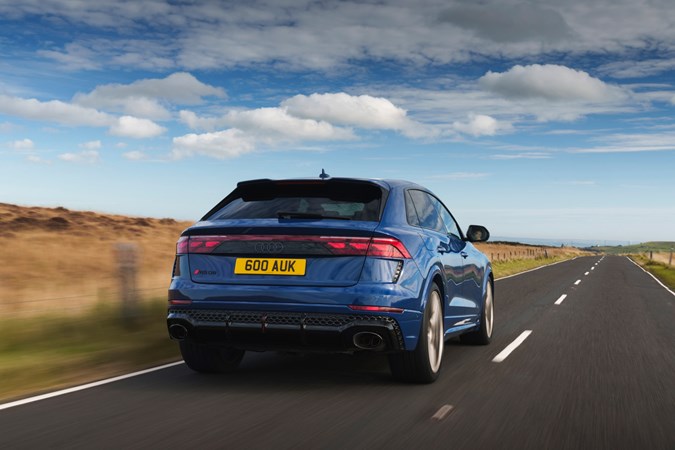
The RSQ8’s V8 engine is a real highlight, with a brutish power delivery that is accompanied by an addictive sound – even more so on the Performance model. As you’d expect from the Volkswagen Group hierarchy, the mechanically similar Porsche Cayenne and Lamborghini Urus adjustability and hooliganism, with no hint of rear bias – this Audi always feels stable and secure, which isn’t a bad thing in this instance.
But perhaps most impressive about the RSQ8 is the way it rides and its surprising ease of use. Though there’s no hiding its sheer size – and particularly, width – it’s easier to manoeuvre than you’d imagine owing to its standard fit four-wheel steering that gives it a turning circle hardly any larger than a regular hatchback. Despite its huge 23-inch alloy wheels, ride comfort is well-judged, with its adaptive sports suspension working wonders to give it a cushioned affect.
What models and trims are available?
Usually, when Audi introduces a ‘Performance’ variant in the UK, the existing model is discontinued. However, with the RSQ8 the two variants will continue to co-exist, though we imagine most buyers will splash out the extra for the latter.
Though the RSQ8 isn’t exactly cheap with a starting price of £120,550, when you consider the other rival SUVs with similar price, the Audi could almost be described as offering good value. You get lots of equipment for the money too, including 22-inch alloy wheels, HD Matrix LED headlights, heated and electric leather sports seats and a 17-speaker Bang & Olufsen sound system to name just a few features.
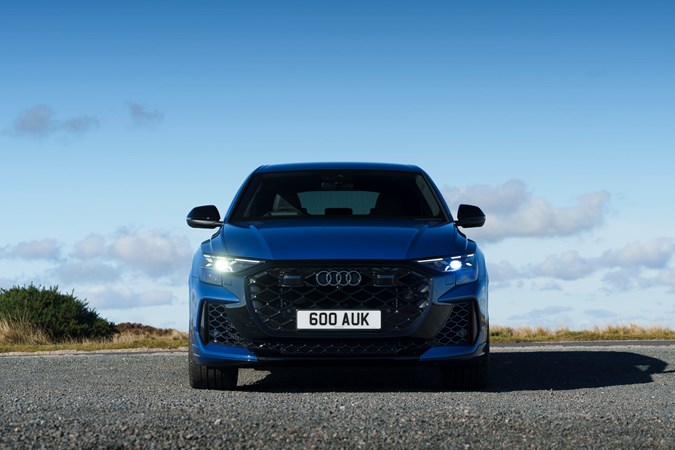
The Performance is quite a step up in terms of price, starting from £135,550, but brings expensive ceramic brakes, a sports exhaust and an additional 40hp under the bonnet. The Carbon Black is available from £148,250, and gains 23-inch alloy wheels, digital OLED rear lights and a matt carbon styling kit.
At the top of the range, the Carbon Vorsprung adds a panoramic sunroof and soft-closing doors, along with various driver assistance features, such as night vision technology and park assist with remote parking functionality.
Read on for the full, expert verdict on the Audi RSQ8.



